 |
| February 02, 2016 | Volume 12 Issue 05 |
Materials News & Products
Designfax weekly eMagazine
Archives
Partners
Manufacturing Center
Product Spotlight
Modern Applications News
Metalworking Ideas For
Today's Job Shops
Tooling and Production
Strategies for large
metalworking plants
Weird stuff: Moon dust simulant for 3D printing
 Crafted from a lunar regolith simulant, Basalt Moon Dust Filamet™ (not a typo) available from The Virtual Foundry closely mirrors the makeup of lunar regolith found in mare regions of the Moon. It enables users with standard fused filament fabrication (FFF) 3D printers to print with unparalleled realism. Try out your ideas before you go for that big space contract, or help your kid get an A on that special science project.
Crafted from a lunar regolith simulant, Basalt Moon Dust Filamet™ (not a typo) available from The Virtual Foundry closely mirrors the makeup of lunar regolith found in mare regions of the Moon. It enables users with standard fused filament fabrication (FFF) 3D printers to print with unparalleled realism. Try out your ideas before you go for that big space contract, or help your kid get an A on that special science project.
Learn more.
Make nylon 3D-printed prototypes and parts in the office
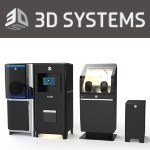 The new SLS 300 from 3D Systems is an affordable, turnkey, closed-loop 3D-printing system designed to operate in a smaller-footprint environment. SLS 300 makes selective laser sintering available to a broader range of customers with a high-reliability, affordable solution to produce end-use parts. Users can produce tough, durable parts from a range of production-grade nylon materials. Amazing fill, finishing, and clean-up systems.
The new SLS 300 from 3D Systems is an affordable, turnkey, closed-loop 3D-printing system designed to operate in a smaller-footprint environment. SLS 300 makes selective laser sintering available to a broader range of customers with a high-reliability, affordable solution to produce end-use parts. Users can produce tough, durable parts from a range of production-grade nylon materials. Amazing fill, finishing, and clean-up systems.
Learn more.
Will it erode? 3D-printing materials comparison from Xometry
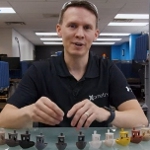 Which 3D-printed plastics are the toughest? In this "Will it ..." video, Greg Paulsen, Xometry's Director of Application Engineering, 3D printed Benchies (3D test models) using different materials (such as polycarbonate, PLA, polypropylene, ULTEM, and Nylon 11 and 12) and processes (such as FDM, SLS, MJF, SLA, LSPc, Polyjet, and DLS) and then ran several abrasion tests on them. Watch to find out which 3D-printed plastic is truly the toughest of them all!
Which 3D-printed plastics are the toughest? In this "Will it ..." video, Greg Paulsen, Xometry's Director of Application Engineering, 3D printed Benchies (3D test models) using different materials (such as polycarbonate, PLA, polypropylene, ULTEM, and Nylon 11 and 12) and processes (such as FDM, SLS, MJF, SLA, LSPc, Polyjet, and DLS) and then ran several abrasion tests on them. Watch to find out which 3D-printed plastic is truly the toughest of them all!
View Part 1.
View Part 2.
Graphene Handbook: Learn all about this wonder material
 Metalgrass LTD has published the 11th edition of its "Graphene Handbook," a comprehensive resource on graphene technology, the industry, and the market for this wonder material made of single layers of atoms of pure carbon. The book includes development history, production methods, current research, an intro to metrology and standardization, and even an investment guide. Under 100 bucks for digital edition. Hard copy available too.
Metalgrass LTD has published the 11th edition of its "Graphene Handbook," a comprehensive resource on graphene technology, the industry, and the market for this wonder material made of single layers of atoms of pure carbon. The book includes development history, production methods, current research, an intro to metrology and standardization, and even an investment guide. Under 100 bucks for digital edition. Hard copy available too.
Learn more.
Who knew? How colorants affect plastic
 In plastic injection molding, one aspect of polymer characteristics that doesn't always get the consideration it deserves is the addition of colorant. Believe it or not, there is a whole scientific body of knowledge about the ways in which adding color to plastic can affect its behavioral properties. This short article by Denny Scher of ICO Mold takes a high-level look at some of the different, and surprising, ways colorants can affect plastics.
In plastic injection molding, one aspect of polymer characteristics that doesn't always get the consideration it deserves is the addition of colorant. Believe it or not, there is a whole scientific body of knowledge about the ways in which adding color to plastic can affect its behavioral properties. This short article by Denny Scher of ICO Mold takes a high-level look at some of the different, and surprising, ways colorants can affect plastics.
Read the full article.
Retaining magnets from JW Winco: Universal and clever
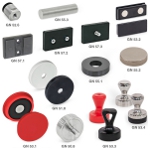 JW Winco has expanded its magnet line to support more applications with new materials, shapes, systems, and even raw magnets. Learn about their latest offerings, including retaining magnets designed for corrosive environments (GN 50.8), encapsulated magnets designed for sensitive or painted surfaces (GN 51.8), handle magnets (GN 53.3), and powerful magnets designed to handle challenging environs (GN 52.6).
JW Winco has expanded its magnet line to support more applications with new materials, shapes, systems, and even raw magnets. Learn about their latest offerings, including retaining magnets designed for corrosive environments (GN 50.8), encapsulated magnets designed for sensitive or painted surfaces (GN 51.8), handle magnets (GN 53.3), and powerful magnets designed to handle challenging environs (GN 52.6).
Learn more.
3D print tool steel with the ease of a plastic
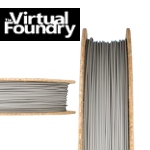 The Virtual Foundry, a pioneer in advanced 3D-printing materials, is excited to announce the launch of their latest innovation: M300 Tool Steel Filamet™ (not a typo). This material answers the demand for FFF 3D-printable Tool Steel, delivering unparalleled strength and versatility. What sets this material apart is its seamless compatibility with various 3D printers, including Creality, Bambu Lab, Ultimaker, and more. The filament prints effortlessly, resembling the ease of working with PLA (plastic).
The Virtual Foundry, a pioneer in advanced 3D-printing materials, is excited to announce the launch of their latest innovation: M300 Tool Steel Filamet™ (not a typo). This material answers the demand for FFF 3D-printable Tool Steel, delivering unparalleled strength and versatility. What sets this material apart is its seamless compatibility with various 3D printers, including Creality, Bambu Lab, Ultimaker, and more. The filament prints effortlessly, resembling the ease of working with PLA (plastic).
Learn more.
Great Resources: Sheet metal design guide
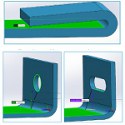 If you're looking for a basic guide to sheet metal design, this one from Xometry will serve your needs well. Follow the design requirements and tolerances in this guide to ensure parts fall closer to design intent. This is the type of information you'll sock away and then refer to again and again.
If you're looking for a basic guide to sheet metal design, this one from Xometry will serve your needs well. Follow the design requirements and tolerances in this guide to ensure parts fall closer to design intent. This is the type of information you'll sock away and then refer to again and again.
Read the full article.
Particle foam perfectly distributed thanks to simulation with Ultrasim
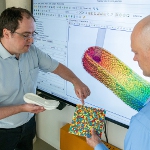 BASF's Ultrasim simulation solution now includes Infinergy, an expanded thermoplastic polyurethane (E-TPU) that is used in a wide range of applications to make components with particle foam -- from bicycle tires to the soles on shoes. Identify and solve problems related to pneumatic filling when distributing particle foams in molds, even taking gravity and mold closing into consideration. Avoid those pesky air pockets.
BASF's Ultrasim simulation solution now includes Infinergy, an expanded thermoplastic polyurethane (E-TPU) that is used in a wide range of applications to make components with particle foam -- from bicycle tires to the soles on shoes. Identify and solve problems related to pneumatic filling when distributing particle foams in molds, even taking gravity and mold closing into consideration. Avoid those pesky air pockets.
Learn more.
Premium polymer DLP printer is half the price of its predecessor
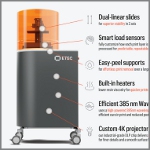 Desktop Metal has just launched the ETEC Pro XL -- a premium polymer digital light processing (DLP) printer that enters the market at less than half the price as its predecessor. DLP is regarded by many as a superior polymer 3D-printing technology for speed, surface finish, and accuracy. Ideal for automotive and machine parts, aerospace components, housings, connectors, jigs and fixtures, short-run molds, and more.
Desktop Metal has just launched the ETEC Pro XL -- a premium polymer digital light processing (DLP) printer that enters the market at less than half the price as its predecessor. DLP is regarded by many as a superior polymer 3D-printing technology for speed, surface finish, and accuracy. Ideal for automotive and machine parts, aerospace components, housings, connectors, jigs and fixtures, short-run molds, and more.
Read the full article.
CNC machining case study: One-of-a-kind computer chassis
 Learn how Josh Sniffen, the YouTuber behind the popular PC-building channel "Not From Concentrate," trusted Xometry to provide a wide range of manufacturing options, personalized Design for Manufacturing (DFM) feedback, and order management support for his latest creation: the HEXO ATX computer chassis. All in all, Sniffen procured parts using Xometry's CNC machining service, selective laser sintering 3D-printing service, and sheet metal cutting and fabrication services. A neat insider look at the process.
Learn how Josh Sniffen, the YouTuber behind the popular PC-building channel "Not From Concentrate," trusted Xometry to provide a wide range of manufacturing options, personalized Design for Manufacturing (DFM) feedback, and order management support for his latest creation: the HEXO ATX computer chassis. All in all, Sniffen procured parts using Xometry's CNC machining service, selective laser sintering 3D-printing service, and sheet metal cutting and fabrication services. A neat insider look at the process.
Read this Xometry case study.
Which parts should be 3D printed? AI combs through CAD files to find out
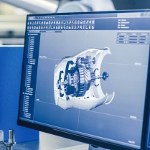 One of the biggest challenges in transitioning to additive manufacturing (AM) is the ability to identify which parts are best suited for the process quickly and easily. Learn how Danfoss, Stanley Engineered Fastening, and even the U.S. military have utilized advanced additive manufacturing software to automate the process, reducing material waste and energy costs, improving part reliability, decreasing lead times, as well as now having the ability to identify part consolidation opportunities through intelligent AM decision-making.
One of the biggest challenges in transitioning to additive manufacturing (AM) is the ability to identify which parts are best suited for the process quickly and easily. Learn how Danfoss, Stanley Engineered Fastening, and even the U.S. military have utilized advanced additive manufacturing software to automate the process, reducing material waste and energy costs, improving part reliability, decreasing lead times, as well as now having the ability to identify part consolidation opportunities through intelligent AM decision-making.
Read the full article.
9 key design tips for injection molding
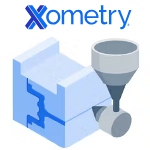 Keep costs down and quality up all while optimizing your injection molded designs with these helpful tips from Xometry. Learn how to build better injection molded parts and products -- using draft angles, ribs and gussets, radii, fillets, and more -- and set expectations for the injection molding process. Good info here.
Keep costs down and quality up all while optimizing your injection molded designs with these helpful tips from Xometry. Learn how to build better injection molded parts and products -- using draft angles, ribs and gussets, radii, fillets, and more -- and set expectations for the injection molding process. Good info here.
View the video.
Metal additive manufacturing: Rocket turbopump design
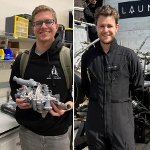 Mixing undergraduate curiosity and real-world engagement, two students from Colorado University Boulder Aerospace Engineering Sciences program, Zachary Lesan and Patrick Watson, started an independent effort on turbopump design and manufacture that is a lesson in determination and industry collaboration. With lots of supplies and advice from industry heavy hitters including Velo3D, CFturbo, SpaceX, and many more, their project has reinforced significant points being made about next-generation rocketry.
Mixing undergraduate curiosity and real-world engagement, two students from Colorado University Boulder Aerospace Engineering Sciences program, Zachary Lesan and Patrick Watson, started an independent effort on turbopump design and manufacture that is a lesson in determination and industry collaboration. With lots of supplies and advice from industry heavy hitters including Velo3D, CFturbo, SpaceX, and many more, their project has reinforced significant points being made about next-generation rocketry.
Read the full article.
Transparent ceramics for extreme optics
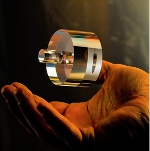 Sapphire is an inherently transparent ceramic material that is resistant to extremes of temperature and environment. Sapphire can be processed to unique and precise shape/form by diamond grinding and polishing to allow full transparency. INSACO is a global leader in this capability -- and working with ultra-hard materials in general.
Sapphire is an inherently transparent ceramic material that is resistant to extremes of temperature and environment. Sapphire can be processed to unique and precise shape/form by diamond grinding and polishing to allow full transparency. INSACO is a global leader in this capability -- and working with ultra-hard materials in general.
Learn more.
Easily integrated metamaterials found to boost sensitivity of MRI machines
A group of researchers from Russia, Australia, and the Netherlands have developed a technology that can reduce Magnetic Resonance Imaging (MRI) scanning times by more than 50 percent, meaning hospitals can drastically increase the number of scans without changing equipment.
This extraordinary leap in efficiency is achieved by placing a layer of metamaterials onto the bed of the scanner, which improves the signal-to-noise ratio.
The details of this experimental research are available in the Jan. 11, 2016, issue of Advanced Materials. This patent-pending technology is currently being co-developed by MediWise, a UK-based company that specializes in commercializing metamaterials for medical applications. Metamaterials are often described as engineered materials with properties not found in nature.
MRI is one of the key methods of modern diagnostics that have found wide applications in medicine, biology, and neurology. MRI scanning helps monitor the subtlest of physiological changes in our internal organs. For instance, a timely MRI procedure can detect tissues affected by cancer in the earliest stage of the disease. The possibility of effective MRI diagnostics, however, depends almost entirely on the quality of resulting MRI images.
Scientists from ITMO University, Australian National University, Ioffe Physical-Technical Institute, University Medical Center Utrecht, and Institute of Experimental Medicine RAMS demonstrated that the quality of MRI images could be substantially increased with the aid of metamaterials -- in this case, artificial periodic structures that can interact with electromagnetic radiation in an extraordinary fashion.
"This is the first real demonstration of the practical potential of metamaterials for MRI imaging enhancement and scanning time reduction. Our research may evolve into new healthcare applications and commercial products," says Yuri Kivshar coauthor of the study, head of the Nonlinear Physics Centre at the Australian National University.
By placing a specially designed metamaterial under the studied object in an MRI scanner, it is possible to increase the signal-to-noise ratio in the scanned area. The result of this increase is that either a higher resolution image can be obtained over the same time slot or faster examination can be performed with the same resolution as in an ordinary MRI scanner. In addition, the metamaterial suppresses the electric field, which is responsible for tissue heating -- a phenomenon that may compromise the safety of the whole MRI procedure.
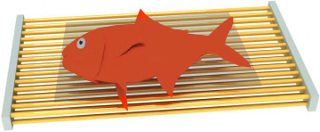
This is an artist's view of a biological object placed on a metasurface resonator.
The problem of tissue heating has recently become even more relevant with the arrival of high-field and ultra-high-field MRI scanners in the medical practice. A drive for high-field MRI is mediated by the benefits of better image resolution. However, tissue heating becomes substantial at higher fields due to an increase of the radiofrequency energy absorption. Therefore, the issue of safety in high-field and ultra-high-field MRI scanners remains open.
The scientific group managed to entirely avoid tissue heating, at the same time preserving high resolution. The solution, in essence, does not require any intervention into the hardware of the MRI scanner, but rather represents an inexpensive functional add-on device that can be used with any existing MRI scanner.
"Our metamaterial can be embedded directly into the patient table of any commercially available MRI scanner. However, in the future we see even more potential in the concept of special smart clothing for MRI scanning," says Alexey Slobozhanyuk, first author of the study and researcher at the International Laboratory of Applied Radiophysics at ITMO University. "Stripes of our metamaterial can be sewn in the clothes. The examination of patients, wearing such clothes, would lead to higher resolution MRI images, while the special design will enable a homogeneous enhancement of the signal-to-noise ratio, which does not pose any risk to the patients' health. As a result, with metamaterials you will be able to improve the characteristics of low-field MRI to the extent that their functionality is comparable to high-field MRI."
The duration of an MRI exam also presumes inconveniences for patients. In ordinary MRI devices, the scanning may last from 15 to 60 minutes, and during this time the patient must remain completely immobile. The possibility of achieving detailed images in a shorter time slot will make the procedure more comfortable for the patient and in the long view could even reduce queue time in hospitals.
"Metamaterials have been proven to add value through their ability to process electromagnetic and sound waves in ways that no natural material can do," says George Palikaras, Mediwise's founder and CEO. "This leads to emerging business opportunities creating genuinely disruptive products. The scientific field of metamaterials is rapidly evolving and impacting traditional industries such as aerospace, telecoms, cleantech, and now healthcare."
You can download a PDF of the research article here.
Sources: ITMO University, Advanced Materials
Published February 2016
Rate this article
View our terms of use and privacy policy
